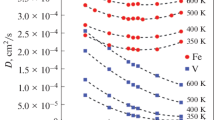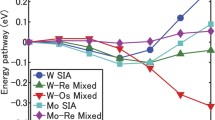Abstract
Two types of intrinsic defect, i.e., vacancy and self-interstitial atom (SIA), are formed in metals during irradiation with energetic particles. The evolution of defect population leads to significant changes in microstructure and causes a number of radiation-induced property changes. Some phenomena, such as radiation growth of anisotropic materials, are due to anisotropy in the atomic mass transport by point defects. Detailed information on atomic-scale mechanisms is, therefore, necessary to understand such phenomena. In this article, we present results of a computer simulation study of mass transport via point defects in alpha-zirconium. The matrix of self-diffusion coefficients and activation energies for vacancy and SIA defects have been obtained, and different methods of treatment of diffusion have been tested. Molecular dynamics (MD) shows that vacancy diffusion is approximately isotropic in the temperature range studied (1050 to 1650 K), although some preference for basalplane diffusion was observed at the lower end of the range. The mechanism of interstitial diffusion changes from one-dimensional (1-D) in a 〈11\(\bar 2\)0〉 direction at low temperature (<300 K) to two-dimensional (2-D) in the basal plane and, then, three-dimensional (3-D) at higher temperatures.
Similar content being viewed by others
References
C. Herzig, R. Willecke, and K. Vieregge: Phil. Mag. A, 1991, vol. 63, pp. 949–57.
G.M. Hood: Defects and Diffusion Data, 1993, vols. 95–98, pp. 755–66; G.M. Hood, H. Zou, R.J. Schultz, N. Matsuura, J.A. Roy, and J.A. Jackman: Def. Diff. Forum, 1997, vols. 143–147, pp. 49–54.
R.A. Pérez, M.L. Aguirre, and F. Dyment: J. Nucl. Mater, 1996, vol. 229, pp. 15–23.
M. Köppers, C. Herzig, M. Friesel, and Y. Mishin: Acta Mater., 1997, vol. 45, pp. 4181–93.
C.H. Woo: Rad. Effect Def. Solids, 1998, vol. 144, pp. 145–69.
D.J. Oh and R.A. Johnson: J. Nucl. Mater., 1989, vol. 169, pp. 5–8.
M. Fuse: J. Nucl. Mater., 1985, vol. 136, pp. 250–57.
D.J. Bacon: J. Nucl. Mater., 1988, vol. 159, pp. 176–89, 1993, vol. 206, pp. 249–65.
R.A. Johnson: Phil. Mag. A, 1991, vol. 63, pp. 865–72.
A.M. Monti: Phys. Status Solidi (b), 1991, vol. 167, pp. 37–49.
G.J. Ackland, S.J. Wooding, and D.J. Bacon: Phil. Mag. A, 1995, vol. 71, pp. 553–68.
A.G. Mikhin, Y.N. Osetsky, and V.G. Kapinos: Phil. Mag. A, 1994, vol. 70, pp. 25–33.
J.R. Fernández, A.M. Monti, and R.C. Pasianot: J. Nucl. Mater., 1996, vol. 229, pp. 1–9.
B.J. Whiting and D.J. Bacon: MRS Symp. Proc., 1997, vol. 439, pp. 389–94.
G. Simonelli, R. Pasianot, and E.J. Savino: Phys. Status Solidi (b), 1995, vol. 191, pp. 249–66.
R. Pasianot and A.M. Monti: J. Nucl. Mater., 1998, vol. 264, pp. 198–205.
R. Pasianot, A.M. Monti, G. Simonelli, and E.J. Savino: J. Nucl. Mater., 2000, vol. 276, pp. 230–34.
M. Wen, C.H. Woo, and H. Huang: J. Comp.-Aided Mater. Des., 2000, vol. 7, pp. 97–110.
Y.N. Osetsky: Def. Diff. Forum., 2001, vols. 187–191, pp. 71–91.
D. Fincham: Dynamical Processes in Condensed Matter, Advanced Chemistry Physics, LXIII (vol. 63), M.W. Evans ed., Wiley, New York, NY, 1985, pp. 493–577.
Y.N. Osetsky, A.G. Mikhin, and A. Serra: Phil. Mag. A, 1995, vol. 72, pp. 361–81.
D.H. Tsai, R. Bullough, and R.C. Perrin: J. Phys. C: Solid State Phys., 1970, vol. 3, pp. 2022–31; A.G. Mikhin and Y.N. Osetsky: J. Phys.: Condens. Matter., 1993, vol. 5, pp. 9121–30.
Y.N. Osetsky, D.J. Bacon, A. Serra, B.N. Singh, and S.I. Golubov: The University of Liverpool, Liverpool, unpublished research, 2001.
Author information
Authors and Affiliations
Additional information
This article is based on a presentation made in the symposium entitled “Defect Properties and Mechanical Behavior of HCP Metals and Alloys” at the TMS Annual Meeting, February 11–15, 2001, in New Orleans, Louisiana, under the auspices of the following ASM committees: Materials Science Critical Technology Sector, Structural Materials Division, Electronic, Magnetic & Photonic Materials Division, Chemistry & Physics of Materials Committee, Joint Nuclear Materials Committee, and Titanium Committee.
Rights and permissions
About this article
Cite this article
Osetsky, Y.N., Bacon, D.J. & de Diego, N. Anisotropy of point defect diffusion in alpha-zirconium. Metall Mater Trans A 33, 777–782 (2002). https://doi.org/10.1007/s11661-002-0144-z
Issue Date:
DOI: https://doi.org/10.1007/s11661-002-0144-z




